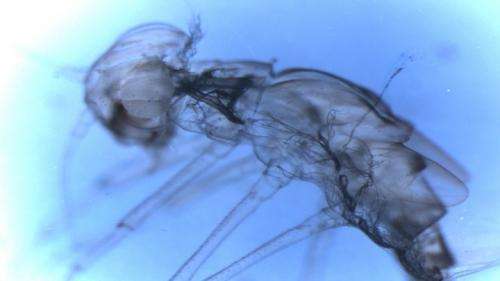Molting tougher on the mayfly than previously thought

It's not easy being a mayfly. Mayflies are insects that spend most of their life in water and provide clues about the health of our streams and other waterways.
Because they are often sensitive to environmental change, such as water pollution, they serve – in simple terms – as canaries in the coal mine.
Not much is known about how or when they shed their skins, or molt, in the water, but mayflies are unusual in that they molt a lot more – 14 to 50 times more, depending on the species – than most other insects.
As if shedding your skin to grow wasn't bad enough – imagine getting out of an almost fully zipped sleeping bag – it turns out that mayflies also shed the lining of their tracheal system, the tubes that deliver oxygen to muscles, nerves and other tissues in the insect's body.
In a somewhat surprising finding made while examining the influence of temperature changes on mayfly respiration, researchers at NC State discovered an irregular breathing pattern in molting mayflies (Cloeon dipterum). Many flies increased their oxygen consumption in the three to four hours leading up to a molting event, and then they all had a sharp decline in oxygen consumption for about 45 minutes, presumably while clearing their airways of their old linings while they escaped their exoskeletons. Then, when their airways finally cleared, they consumed huge amounts of oxygen for about 45 minutes to make up for the oxygen debt associated with the molt.
The mayfly's experience could be likened to a human dive into deep water, albeit at a longer time scale. You prepare by filling your lungs with oxygen with a big breath intake and then slowly use that oxygen up in the water. When the dive is completed and you hit the surface, lungs spent, you grab a large amount of oxygen with a huge gasp.
"We were looking at what happens to mayfly breathing when you increase water temperature and came across this finding serendipitously," said Allison Camp, an NC State Ph.D. student in Dr. David Buchwalter's lab in environmental and molecular toxicology and first author of a paper describing mayfly respiration published in Freshwater Science. "Further, we found that larvae molt more frequently at warmer temperatures and that the molt is more disruptive to breathing as temperatures increase.
"We know from the academic literature that larvae tend to stop eating before and after the molt, and there seems to physical stress and caloric loss associated with molting, but we were unable to find any papers that examined respiratory disruption during the molt itself," Camp added. "Mayflies also seem to be more sensitive to other stressors in the water. Does molting exacerbate this sensitivity? And what happens if water temperatures rise as the climate changes?"
This finding, Camp says, may raise even more questions for researchers.
"Molting occurs in all insects, so how do these respiratory patterns found in the mayfly compare with other species?" Camp said. "How often do other species molt and what is the duration of each of those events? These are some of the questions we'd like to tease out in our work."
More information: "A stressful shortness of breath: molting disrupts breathing in the mayfly Cloeon dipterum." A. A. Camp, D. H. Funk, and D. B. Buchwalter, Freshwater Science 2014 33 (3), 695-699 doi: DOI: 10.1086/677899
Provided by North Carolina State University



















